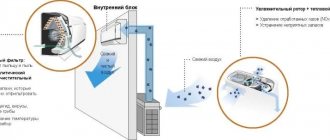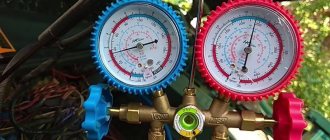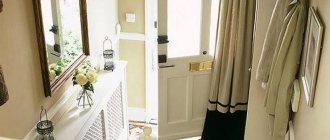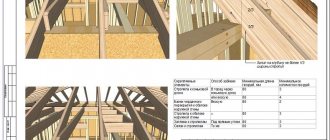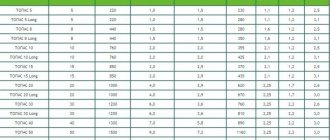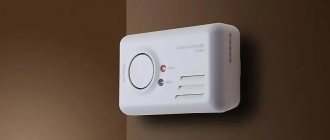The air conditioner allows you to adjust the temperature in the room if for some reason it does not suit you.
But to know how to choose the right air conditioner for your home, you need to understand its structure and features.
In the material we will give useful tips that will be useful to you during the purchase.
A home air conditioner is a device that helps maintain optimal climatic conditions in your home.
How the air conditioner works: advantages and disadvantages
Most buyers perfectly understand the purpose of an air conditioner, but at the same time they have little knowledge of how it works.
And therefore, there are cases when, after installation, users cannot cope with maintenance, since they initially did not choose the right air conditioner. Let's look at the structure and operating principle of this technique.
The first association with air conditioning is cold. But modern models can not only produce a cooling air flow, they can also heat. This is very useful in houses where the radiators do not heat up well in winter.
Typically the air conditioner is a split system. It consists of two blocks, one is mounted outside the window, and the second is installed at home. The blocks are connected by special tubes.
also mobile air conditioners that stand directly on the floor and can be easily moved. When choosing an air conditioner, keep in mind that they cool no worse than split systems.
The operating principle of the air conditioner is based on the laws of physics from school. Recall that when a substance expands, it absorbs heat. And if, on the contrary, it contracts, it gives off heat.
If you study the operation of a classic split system, the substance in it is freon gas. It is capable of changing from liquid to gas and back. It goes along the snakes in two blocks.
The refrigerant in the outdoor unit is in the form of gas. It also has a compressor that puts pressure on the gas . And at the same time there is a large amount of heat escaping into the atmosphere.
The compressed gas enters the home unit, where it evaporates and absorbs heat from the air. There is also a fan in the indoor unit, thanks to which warm air from the room passes through the coils and returns to it already cooled. The process is cyclical, and you can set the degrees as desired.
If the air conditioner is set to heating, then the steps are the same, only in reverse order. Hot freon enters the tubes in the indoor unit.
Despite the simple principle of operation, it is better to choose an air conditioner for an apartment not the one that costs less. The rule works here: “More expensive is better .
Now let's talk about the advantages and disadvantages of an air conditioner, which are also important if you want to know which air conditioner to choose.
pros
Rescue from heat or cold in winter if utilities do not heat well;
The air conditioner absorbs dust, pollen, fur and other debris that people with allergies or asthma react to.
Minuses
You can get sick if you set the temperature incorrectly;
The air conditioner needs to be cleaned 1-3 times a month, otherwise the filter becomes clogged with harmful microbes, which can cause colds and other diseases. When choosing an air conditioner for your home, keep in mind that the filter needs to be changed regularly;
Reduction of humidity during operation of the air conditioner to 30-40% when the norm is 30-60%, which can cause the mucous membranes of the mouth and respiratory tract to dry out. Again, you may get sick, and to prevent this from happening, use a humidifier.
Additional tasks that an air conditioner can perform
The main function of an air conditioner, of course, is to cool the air in residential or non-residential premises. However, the capabilities of modern split systems are much wider. Many of them are capable of performing a number of other tasks, namely:
- heating;
- drainage;
- hydration;
- ventilation.
Many modern air conditioners can heat, but they should not be considered as heating devices. It is not recommended to turn on the split system in heating mode in winter frost. Firstly, it still won’t be able to fully warm up the room. Secondly, at low temperatures the oil in the compressor thickens and loses its properties, as a result of which cold starts lead to premature wear of parts. The heating mode is more often used in the off-season, when the heating season has not yet begun or has already ended, and the weather outside is already (or still) cool (–5°C…+5°C).
In humid climates, the dehumidification mode found on some air conditioners will be useful - it can significantly improve heat tolerance. However, an air conditioner, even without this function, dries out the air greatly, and this should be taken into account when choosing climate control equipment.
Residents of regions with an excessively dry climate, on the contrary, require air humidification, which air conditioners with a humidification mode cope well with. Since excessively dry air is harmful to the respiratory system, such air conditioners may be useful for people with lung diseases, but it would be a good idea to consult a doctor before purchasing.
And finally, the air conditioner may not cool or heat the air, but simply “drive” it with a fan. This helps create a uniform temperature background in the room, i.e. uniform distribution of warmer or colder air in it.
What types of air conditioners are there?
Before thinking about which air conditioner is better to choose, in addition to its design, you should understand the types.
Window air conditioners
This technique is attached inside the window, but has significant drawbacks in operation. Firstly, the structure itself is so large that it will cover a good part of the window, therefore, there will be less light. Secondly, if the opening is poorly sealed, it will blow, and the air conditioner itself is noisy.
Floor standing air conditioners
They are easy to install, but cannot be called effective. If you set the power incorrectly, there will always be a draft, and as a result, it’s easy to get sick. And floor systems require a lot of free space for installation.
Duct air conditioners
Installed in the ventilation itself. The advantage is that the air conditioner is unnoticeable and does not ruin the overall integrity of the interior, so choose it if the interior is especially important. The disadvantage is complicated installation and maintenance, as well as high price.
Cassette air conditioners
Cassette air conditioners are installed near the ceiling, so the cost of installation depends on the ceiling itself, and not on the air conditioner. At the same time, installation is simpler than the previous model.
Mobile air conditioners
You can move from one and the system not only cools, but also heats. And it has convenient control - the kit includes a remote control. Disadvantages include noise and during installation you need to make a hole in the wall for air venting.
Split systems
The air conditioner consists of two blocks - indoor and outdoor. Users like it for its relative silence, convenient controls, the ability to customize the air conditioner, and so on. A popular type of air conditioner that customers choose.
Multisystems
Multisystems differ from split systems by the presence of not one, but several home units. Very useful if you need to set different degrees in rooms. But installation will require the help of a specialist, as with a split system.
Don't forget about energy efficiency
Air conditioners have an energy efficiency coefficient for the cooling mode (marked EER - Energy Efficiency Ratio) and heating mode (COP - Coefficient of Performance). They are calculated using various formulas, but in the end all values are reduced to classes familiar to household appliances: from A (the highest) to G (the lowest).
Depending on the operating mode, the energy consumption class of the air conditioner may be different. For example, in cooling mode - A++, and in heating mode - A+.
If you want to save energy, you will have to fork out a fair amount for the unit itself. Prices for class A+++ split systems start from 60,000 rubles. However, it is not always worth overpaying.
For example, if we compare models designed for 25 square meters, class A+++ air conditioners consume on average 500–600 watts of energy, and A++ analogues consume 700–800 watts. Moreover, the difference in their prices can reach 50%. If you have a limited budget, it is better to find the best A++ class option.
Photo: shopplaywood/Shutterstock
To this day, there are also air conditioners on sale with energy consumption classes B, C and even D. These are either very powerful systems for large areas, or the cheapest models. But there is no need to save money here. A model with energy consumption class A and higher will be only a few thousand rubles more expensive. This overpayment will quickly show up in your electricity bills.
Home air conditioner noise level
No matter what air conditioner you choose for your apartment, you cannot completely get rid of the noise emanating from it. Inside the system, its parts operate smoothly and air exchange occurs.
If we talk about the amount of noise, it depends on what kind of air conditioner you have chosen; power, installation location, and more also affect.
Which air conditioner is better to choose for an apartment so that it makes less noise:
- Look at the instructions. It shows dB for the outdoor and indoor units. Of course, you need to look mainly at the internal one, since it will be located at home. Comfortable noise for the human ear is 24-35 dB.
- The split system makes less noise because it is divided into two parts. If the air conditioner is from one box, then it collects all the noise in itself.
- At night, you can hear any sounds better, so the air conditioner seems to be louder at this time. If you choose an air conditioner for the bedroom, make sure there is a night mode. It will suppress noise up to 17 dB, but will also reduce the power of the system during operation.
What is important to know about installing an air conditioner
A split system consists of an external unit, installed on the street side, and an internal unit, which is installed directly in the room. Electrical and freon communications are laid between the blocks. The connection is carried out by qualified specialists using special tools in their work.
When installing the indoor unit of a split system, it is important to ensure free circulation of air in the room, without any obstacles to the cooled air flow.
The external unit must be protected from various influences that can damage the device: heavy rain, falling icicles or avalanches from the roof. The structure is mounted on the outside of the building using high-quality fastening elements. It is advisable to install the device on the shady side, under a window with an opening sash, which will provide convenience for maintenance.
There are also monoblock floor and window air conditioners. The design is extremely simple, all working components are immersed in one housing.
It is prohibited to install external air conditioner units on glazed balconies that prevent heat from escaping, as well as close to the ground, near trees and gas communications.
When installing an air conditioner, be sure to consider condensate drainage. Do not allow water to get on the wall. The installed sewage system, which can also be included in the equipment installation project, will eliminate such wetting.
What is the optimal air conditioner power?
To choose the right air conditioner for your apartment, you need to decide on its power. To do this, you need to know the area of the room, the height of the ceilings, the number of people living and other parameters. Equipment that additionally warms the room also has an effect.
How to choose an air conditioner based on the size of the room? As a general rule, per 100 W of power there is 1 sq. m. premises. That is, a system with 2-2.5 kW is enough for a room of up to 20 square meters. m., if there are no other heat sources.
In the instructions, almost all manufacturers indicate for which room the equipment is designed. But according to user comments, this characteristic is often overestimated, so it is better to buy an air conditioner with a small power reserve or read customer reviews in advance.
Do not forget about the height of the ceiling, if it is higher than 3 m, then the formula is “for 100 W 1 sq. m." needs to be fixed to buy a more powerful air conditioner.
What happens if you choose an air conditioner of the wrong power? The equipment will still work, but it will quickly break down. Therefore, here you do not save, but rather, on the contrary, spend more. If you buy an air conditioner with excess power, then the energy consumption will be unnecessarily high.
Kinds
There are many types of split systems, which differ in power, location of operation and shape.
Wall-mounted
It is called household or domestic, since it is more often installed in residential premises. The advantage of this type is its low cost, since it can be purchased for 12,000 rubles. As a standard, the outdoor unit is installed under the window, and the indoor unit is mounted under the ceiling for a larger airflow radius.
Ceiling and floor-ceiling
This type of split system is less common, but convenient. The indoor unit can be installed at the bottom of the wall or on the ceiling, but only if you do not have a suspended ceiling. If the device is installed in the lower part of the room, then the air flow will be directed upward, and the ceiling air conditioner will blow horizontally. This will save you from direct hits, and the room will cool evenly.
There are improved designs that can simultaneously capture four directions, and using the control panel you can change the power of each of them.
Channel
The device is more often used in offices and shops, since its average power is 10–23 kW. A special feature of such split systems is the ability to cool several rooms at once. By default, the jet flow is supplied equally to all branches, so if you want to supply a separate temperature for each room, you will have to install additional electric drives and thermostats in each room.
Multi split systems
The device consists of one outdoor unit and several indoor ones. It allows you to cool up to 5 rooms at the same time, and the temperature of each unit can be changed using a remote control.
Due to the large number of hoses, compressors, conductors and fans, installing a multi-system is difficult and time-consuming. The design is most often used in complex business centers and industrial premises, which is why it is called industrial.
There are two types of multi split systems:
- Fixed. Provided as a ready-made kit. You can independently select the required number of indoor units. In the future, you will not be able to add or remove blocks yourself.
- Typeset. This option is distinguished by the ability to simultaneously connect a different number of blocks.
The universal device makes it possible to connect any type and type of unit.
Inverter
The inverter type of device is equipped with an electric drive that can automatically regulate fan speed. If you set the appropriate temperature, it will maintain it not by constantly starting the electric drive when the indicators change, but by constantly changing the speed. That is, the engine will run constantly, gradually changing speed. Such an electric drive is relevant in places where people are constantly present. These include offices, shops, conference rooms and other public places.
The inverter air conditioner differs from the standard one in lower energy consumption and greater engine wear resistance.
Split systems for allergy sufferers
For allergy sufferers, there are floor and wall air conditioners. A wall-mounted type of device will be more effective at purifying the air, since due to its complex design, improved filtration will occur. Externally, the split system for allergy sufferers is no different from the standard one, but it has a compartment for a filter. Budget models have limitations on the type of filters, since a complex filtration procedure will require a powerful compressor. Expensive split systems are equipped with several thresholds, creating stepwise filtration.
Designer models
The process of processing, cooling or heating air in designer split systems occurs in the same way as standard ones. The whole difference lies in appearance. Such split systems are usually distinguished by unique shapes and colors so that they can best match the interior.
Disguised air conditioners that represent paintings or some unique material are gaining popularity on the market. Moreover, the shape of the split system is no longer standard, but square, rectangular or rounded. As a rule, such devices are considered the most expensive.
Ways to control an air conditioner for your home
Some models provide mechanical control. This is when you can enable one of the modes. For example, a fan and extreme cold. When choosing such an air conditioner for an apartment, it will be difficult to adjust the exact degrees.
Most modern systems are equipped with more fine-tuning settings, where you can set the exact temperature, set the time and choose between power modes. These models have a remote control that allows you to conveniently control the air conditioner.
If the air conditioner has a display, then you will see the temperature, mode, and so on. It's definitely convenient.
Markings from manufacturers
When purchasing a split system, you can immediately find out about its main parameters without taking out your passport. Basically, the brand markings are the same, but Chinese manufacturers may change it.
The box or block depicts a special code of letters and numbers, each of them indicates a specific characteristic, namely:
- refrigerant type;
- electric drive power;
- the lineup;
- type of power supply.
As a standard, the first letters indicate the brand name and block type.
Additional device features
When deciding which air conditioner to choose, you should consider additional functions:
- Heating for winter.
- Filter.
- Inversion - the ability to regulate the power of the compressor and save on electricity, reduce the noise level.
- Ionization.
- Ventilation.
Of course, the more useful functions a device has, the higher the price. Therefore, weigh the pros and cons of each additional parameter. For example, the “comfortable sleep” mode allows you to reduce the noise from the air conditioner when its power is reduced.
And the forced mode quickly heats the room with increasing power.
The climate control function is considered especially expensive. If there is one, then the air conditioner itself “thinks” and determines which mode is suitable for this room. It does this based on sensors that scan temperature, humidity, and air quality.
Another useful feature is self-cleaning. If you choose an air conditioner with it, then after turning it off, it will dry itself inside with an antiseptic. This will prevent the growth of bacteria - the cause of your illnesses.
And when choosing an air conditioner for your apartment, ask about its filters. Many models are equipped with them, which allows you to remove stench, dust, and so on. Filters are:
- Coal . Cleans the room from odors and harmful impurities.
- Plasma . Help people with allergies. Clean the air from dust and so on.
- Nanofilters . They not only remove dust, pollen, wool, but also ionize.
- Ultraviolet . They disinfect the air, but during their operation the room must be left.
- And others.
The best manufacturers of climate control equipment
The ease of use of the air conditioner, its functionality and, most importantly, reliability depend on the choice of supplier. To make it easier to decide, let's make a list of the best manufacturers.
Place #1 - sophisticated Daikin air conditioners
The company has been successfully operating in the market for more than four decades. During this time, Daikin has established itself as a supplier of multifunctional and high-quality household appliances. Its employees pay special attention to manufacturing technology, as well as after-sales service of the device.
Daikin factories are located in Japan, Belgium and Thailand. This production base allows us to produce more than 2.5 million air conditioners every year
The manufacturer presented above has recently been a market leader, offering customers a good range of Daikin split systems. All brand products are of decent quality.
Therefore, when placing an order, you can count on the environmental friendliness of the device, its high quality and durability. But keep in mind that such a set of benefits will be expensive.
Place #2 - Mitsubishi semi-industrial equipment
Mitsubishi is in second place among companies producing household and semi-industrial climate control equipment. Most of the devices of this brand belong to the elite class, but the range also includes relatively inexpensive models. We recommend that you familiarize yourself with the rating of the best air conditioners of the brand.
If you decide to go with this brand, then pay attention to inverter units. As a rule, they are equipped with several automatic operating modes, as well as an ionizing air purification function.
Place #3 - perfect mid-range Toshiba
For those who want to save money, Toshiba produces mid-range air conditioners. The company has been operating on the market for more than 120 years, and it was its engineers who created the first split system for a New York printing house.
The distinctive features of devices from this brand are reasonable prices, high reliability, and a huge range of functions. At the same time, most models are equipped with an inverter compressor, which allows you to save on electricity.
Place #4 - innovative Fujitsu split systems
The fourth place in the ranking was taken by the Japanese company Fujitsu. Its range is full of semi-industrial and household air conditioners.
It is this company that is the first to introduce innovative developments, setting the trend in the climate control equipment market.
Fujitsu technique is classified as expensive. This is explained by the fact that air conditioners are equipped with a huge number of different sensors. This engineering solution helps protect the device from freezing, power surges and excessive current.
Place #5 - reliable Panasonic equipment
The last place in the TOP is occupied by another Japanese brand. Panasonic produces industrial split systems, as well as household models. With each new device, you can see how the company improves the quality of materials, increases manufacturability and increases the number of functions.
Panasonic models of all price categories are available on the market. But if you can afford to spend a little more, then pay attention to split systems equipped with generators and air ionizers, as well as a catechin filtration system.
Classic or inverter?
For many years, all cooling appliances, including air conditioners, worked this way. The compressor started, gas ran through the coils, the room cooled, and the device turned off. This is where the vulnerability lies.
When choosing such a classic air conditioner, you must take into account the degree of wear.
It does not occur while the equipment is operating, but when it starts and stops. The compressor has to be repaired frequently, which is expensive. In addition, after turning on the engine runs at full power, it becomes cold. And there is a lot of noise, as well as electricity consumption.
Therefore, today many users choose an inverter air conditioner instead of a conventional air conditioner. The compressor does not turn off, it just starts working slower and does not cool. If the air temperature rises again, the system itself will sense it and increase speed.
Inverter air conditioners maintain temperature better and last longer than classic ones. And they consume less energy, which is nice for the wallet, and also work in winter. Of course, the price of an inverter system is higher, but it's worth it.
How does the air conditioner work in different modes?
After we got acquainted with the main modes of the air conditioner and their purpose, it is time to find out how the device works in each of these modes.
Cooling mode (Cool)
When the air conditioner is turned on in cooling mode, refrigerant, which is in a gaseous state at this stage, begins to flow from the evaporator into the compressor. In the compressor, the refrigerant is compressed, its pressure increases from 3-5 to 15-25 atmospheres, and at the same time it heats up to 70-90°C. Next, the compressed refrigerant is sent through the circuit tubes to the condenser.
There, thanks to the intensive operation of the fans, it is gradually cooled to 30-40°C. As the refrigerant cools, it condenses. In the capillary tube, where the liquefied refrigerant enters at the outlet of the condenser, there is a partial drop in its pressure and a further decrease in temperature. Once again in the evaporator, the liquid refrigerant turns into a gaseous state, while heat is actively absorbed from the outside. As a result, the air pumped into the air conditioner and passing along the evaporator is cooled. The refrigerant gas flows back into the compressor and the cycle repeats.
As you can see, the principle of operation of an air conditioner is no different from a refrigerator. Only the refrigerator freezes its chamber and releases excess heat into the space, while the air conditioner cools the room and removes excess heat to the street.
Heating mode
In order for the air conditioner to operate in heating mode, it is equipped with a special four-way valve that can change the direction of refrigerant flow. The principle of operation in this mode is similar to that described above. The only difference is that the refrigerant goes through the stages of increasing and decreasing temperature, high and low pressure in reverse order, i.e. the blocks functionally change roles. As a result, the condenser located in the outdoor unit is cooled, and the evaporator of the indoor unit is heated. The latter releases the accumulated heat to the air pumped by the air conditioner fan.
Dry mode
When the air conditioner operates in dehumidification mode, the moisture contained in the room air condenses on the cooled surface of the evaporator. The condensate accumulates in a special tray and is gradually discharged through a plastic drainage tube into the sewer system or onto the street. In theory, when the air conditioner operates in this mode, the temperature in the room should decrease, which is not always necessary. Reducing the speed of the fan pumping air helps to avoid this: moisture condenses on the radiator, but the air temperature in the room remains virtually unchanged.
Ventilation mode (Fan)
When the air conditioner operates in ventilation mode, its compressor is turned off, and the movement of refrigerant through the system completely stops - only the fan of the indoor unit works, mixing the air inside the room.
Split system or mobile solution?
It is not always possible to install a split system, for example, when the windows face the main street. Or the user simply does not want to have such a large air conditioner at home when he does not plan to use it regularly. Then you can choose a mobile air conditioner that is easy to rearrange and can also be taken with you to the dacha.
A mobile air conditioner is one unit with a compressor and a cooling system. When choosing such an air conditioner for your home, pay attention to the pros and cons.
pros
An excellent functional system that is no worse than a split system;
Easy installation, no need to call a specialist for help;
Possibility to take the air conditioner with you.
Minuses
The need to install a movable pipe to remove hot air;
High noise level;
Lower power due to design. It is enough for a small apartment, but not enough for an office or a large house.
Pay attention to the compressor
The advantage of split systems is the inverter compressor. The control unit in such air conditioners converts alternating current into direct power and then again into alternating current at the required frequency. This allows you to control the rotation speed of the compressor motor and smoothly regulate the room temperature.
However, it is more important for the buyer to know that inverter air conditioners are more reliable and more economical. Yes, they are more expensive, but the overpayment upon purchase is compensated by electricity bills. Compared to non-inverter analogues, the difference in energy consumption can reach 30–40%.
Rules for operating a home air conditioner
After you have chosen an air conditioner for your apartment and start using it, learn the rules:
- Do not turn on the equipment if the temperature is lower than in the instructions. Some models cannot work when it is cold, and may break if started this way.
- Close the windows while the air conditioner is operating. The power is designed for a certain volume of air and when additional volume is supplied, it will work without interruption. This will lead to unnecessary energy costs, wear and tear, and even equipment breakdowns.
- Do not place cabinets or other furniture in front of the air conditioner. Do not cover it with a curtain, thereby reducing the efficiency of work.
- Do not install the system near heat sources. Otherwise, the air conditioner will count, for example, the heat from the TV as room temperature and set its parameters differently. And do not install the air conditioner in the sun.
- When cleaning, turn off the air conditioner to avoid overloading the filter.
- Keep an eye on the humidity. If it is higher than normal, then mold and other harmful organisms may appear in the air conditioner.
What does the market offer?
Today, consumers have at their disposal many interesting models of split systems for homes, offices and apartments. Below we present the most interesting models.
Toshiba
Toshiba has pleased customers with many new products, including:
- Toshiba type RAS-07S3KHS-EE / RAS-07S3AHS-EE is a wall-mounted split system that is suitable for a home, apartment or office. The cooling area is 20 square meters. meters, and the maximum length of communications is 10 m. Features of the device include the presence of a ventilation mode, independent diagnosis of problems, a dehumidification mode and temperature support in the “automatic” mode. Maximum power consumption (for heating) - 1.94 kW. Manufacturer: Thailand.
- Toshiba, model RAS-22N3KVR-E / RAS-22N3AV-E is one of the manufacturer’s interesting new products. This is an inverter device for apartments and houses, designed for an area of 60 square meters. Power consumption for heating and cooling is up to 7.5 and 2.65 kW, respectively. The features of the split system include the presence of a 2-stage air purifier, which provides maximum effect thanks to silver ions. The maximum length of communications is 20 meters. Additional functionality - the presence of a ventilation mode, fault detection, maintaining the temperature in automatic mode. The noise level is in the range of 35-47 dB.
LG
LG products are no less interesting:
- LG A09AW1 is a split system with inverter control type, manufactured in Korea. The area of the refrigerated room is 22-27 square meters. meters. This is a wall mounted air conditioner with heating and cooling capacity of 3.5 and 2.7 kW respectively. Additional modes include self-diagnosis of breakdowns, automatic mode, the presence of additional filters (deodorizing and flame), the ability to regulate, a memory function, as well as a warm start.
- LG G07HHT is a split system with basic heating and cooling modes. Power consumption in heating and cooling mode is 2.7 and 2.5 W. Additional functions - dehumidification mode, on/off timer, remote control, fan speed control, option to remember settings and others. This is a simple split system for a house or apartment, which is characterized by its simplicity of design and reliability.
Midea
Chinese manufacturer Midea also offers many options. Below we consider two interesting models:
- MSMA1A-07HRN1/MOAB02-07HN1 is a wall-mounted split system that fits perfectly into the interior of a house, apartment or cottage. The peculiarity of the device is its wide functionality, relatively low price, and modern appearance. It provides options such as accelerated cooling, working with a temperature sensor, remembering settings and others. If the owners are absent for a long time, the unit can maintain the temperature for a long time, heating the room. The device is designed for an area of up to 21 square meters and operates in cooling or heating mode. Power consumption from 2.1 to 7.0 kW.
- Model MSMBB-12HRN1(W) / MOBA02-12HN1 is a high-quality split system designed for an area of 28-36 sq. m. meters. The product has a new design, has a comfortable sleep mode, a self-diagnosis function and an economic mode. If there is a refrigerant leak, the user is notified that there is a problem. The power consumption of the air conditioner is 3.5-3.6 kW in various modes. There is a remote control, as well as a timer to turn it off and on.
Mitsubishi Electric
Today, Mitsubishi Electric products are manufactured in Thailand. Below we look at several models:
- MSZ-DM25VA / MUZ-DM25VA is an inverter split system designed for an area of 22 to 27 square meters. meters. The power in cooling and heating modes is 2.5 and 3.15 kW, respectively. Among the useful options, it is worth highlighting the presence of a ventilation mode, self-diagnosis and a dehumidification mode. Control is carried out using the remote control. An important advantage is the presence of an option to remember settings, a system against ice formation, as well as changing the direction of air flow.
- MSZ-FH25VE / MUZ-FH25VE is an inverter-type split system. The power of the device is 2.5 and 3.2 kW in cooling and heating mode. There is a ventilation mode and automatic diagnostics. The area of the refrigerated room (apartment, house) is 22-27 square meters. meters. Among the additional functions, it is worth highlighting the presence of deodorizing and plasma filters, an ice protection system, an option to remember settings, and others.
Electrolux
Equipment under the Electrolux brand never ceases to pleasantly surprise. Let's highlight several models:
- EACS/I-07HSL/N3 is one of the highest quality and reliable split systems for an apartment or house, designed for an area of up to 21 square meters. meters. This is wall-mounted equipment with inverter control and low power consumption (2.1-2.6 kW). There are dehumidification and ventilation modes, there is self-diagnosis of breakdowns and adjustment of the fan speed. Additional options include a warm start, an option to remember settings, the ability to regulate air flow and others.
- EACS - 07HPR/N3 - split system from the Prof Air series. The average area of the room for which the device is designed is 20 square meters. meters. Power consumption is about 650 W. The main feature of such systems is the presence of a unique technology that ensures the cleaning of all air conditioner elements and air flow. At the same time, anyone can clean the filter.
Hyundai
It is impossible not to highlight several models from the manufacturer Hyundai:
- H-AC-07H1 is a split system designed for cooling or heating an area of up to 21 square meters. meters. The power of the device is 2.2-2.3 kW depending on the selected mode. Features include the presence of an ionizer, a convenient display, a remote control, and air purification filters. This is a reliable device that operates in several modes - heating, cooling, dehumidification and ventilation.
- H-AR7-07H is a split system from the Prime series. The air conditioner is designed to operate in a room with an area of up to 22 square meters. The model features an exclusive design, original indicator lights, many functions and operating modes, as well as an automatic shut-off timer. The power of the device is 2.2-2.3 kW depending on the mode. There is a display and control panel.
Neoclima
Many experts recommend products from the increasingly popular Neoclima brand. Let's highlight several models:
- NS-09AHQ / NU-09AHQ - split system for 25 sq. meters, with a capacity of 2.64 and 2.78 kW for cold and heat, respectively. Control is carried out via the remote control. The features of the model include the presence of a wave filter, a wide range of operating temperatures, relatively small dimensions and quiet operation. Heating work is carried out up to seven degrees below zero.
- NS-18AHQ / NU-18AHQ is a powerful split system that is suitable for a large apartment or house. The maximum area that the air conditioner can cover is 50 square meters. meters. Control is carried out from the remote control. Features: white color, sleep function, wide range of operating temperatures, compactness and low noise level.
Samsung
The popular Samsung brand deserves special attention, as it also offers customers a wide selection of air conditioners. Let's highlight some options:
- AR09KQFHBWKNER is a model that copes with heating or cooling a room up to 27 square meters. meters. The maximum length of the route during laying is 15 meters. The device is controlled via the remote control. The block is wall-mounted. A Full HD filter is installed inside, providing maximum air purification. The device can be turned on for heating down to five degrees below zero.
- AR12MSPXBWKNER is an air conditioner model that will be an excellent option for home and apartment. The device has enough power to heat/cool a room up to 35 square meters. meters. To clean the air, a special Virus Doctor filter is installed, which ensures the removal of harmful microbes. The consumption of the device is about 1 kW, and starting heating is possible even at 15 degrees below zero.
Daikin
Daikin offers customers split systems of several series. Let's look at some of them:
- ATXN-MB is a new series of air conditioners that can provide an optimal microclimate in the apartment and clean the air from foreign impurities. Features of split systems include the presence of a 2-row heat exchanger with gold plating, as well as improved main characteristics, including performance and energy efficiency. Devices in this series are distinguished by the presence of a powerful inverter, which ensures rapid achievement of the required temperature with minimal noise and low energy consumption.
- FTXB-C is an improved inverter-type split system with low noise levels and high-quality European assembly. The device is manufactured in the Czech Republic, which guarantees a long product life. The advantages of the series include the presence of an additional filter against animal hair, ticks, viruses, bacteria and various contaminants. Thanks to the presence of an inverter, the device quickly reaches the required temperature and wears out less. In this case, the cooled air is evenly distributed throughout the room.
- ATX are split systems that do an excellent job of cooling, dehumidifying, heating or ventilating air. The air conditioner operates thanks to a powerful compressor equipped with an inverter drive. During the development process, all current market trends, as well as customer wishes, were taken into account. Assembly is carried out in the Czech Republic, which is a guarantee of high quality. Thanks to the inverter, the desired temperature in the room is reached quickly and without jumps.
Installing a split system is a justified decision, because with its help you can ensure a comfortable temperature in any room, be it a house, apartment or office.
But to achieve the greatest efficiency, it is important to involve experienced installation specialists, because improper installation can eliminate all the advantages of the air conditioner and reduce its service life.
Mobile
There are times when you may regret that the air conditioner is not a kettle, fan or microwave; you cannot take it with you and put it in another place without dismantling it. For those who experience such feelings, mobile air conditioners were invented. Externally, they look like a small vertical box.
Communication with the external environment is realized using a special flexible pipe of round cross-section. With its moderate power, a mobile air conditioner is good for everything, except that the outlet pipe needs to be mounted somehow.
Question answer
Is it possible to take a back-to-back power split?
Not worth it. It's better to have a reserve in case of a very hot summer. And the room of a more powerful model will cool faster.
To what extent can an air conditioner operate for heating?
For regular splits this is by default 5 – 7 degrees below zero. For inverters – up to – 10°. Equipment with a special winter kit can be used down to -25°C.
What most often breaks down in air conditioners?
According to statistics, 70–80% of breakdowns and malfunctions occur due to poor installation. Frequent breakdowns - depressurization of the system (freon leaks), clogged drain system, electronic failure.
Choose a split system wisely, guided by the good reputation of the brand, functionality and price attractiveness of the product.
Window
Historically, these were the very first types of air conditioners, and they were the first to become widespread in our country. The window air conditioner is mounted on a monoblock principle in one housing. It is inserted into one of the window sections so that a tight abutment contour is ensured. During operation, cold or heat is removed from the external grille to the street, and air of the desired temperature is blown from the internal grille.
Window air conditioners are attractive because they are a single piece and are not very expensive. In all other respects, they are inferior to their competitors in terms of convenience, because today rarely anyone would change double-glazed windows in order to install a bulky block.
The use of window air conditioners today is justified for a summer house, warehouse, garage and other premises where it is possible to easily install a “window”.
How to choose the ideal location for the indoor unit
There are general recommendations for placing the indoor unit, regardless of the purpose of the room:
- the flow of cold air should not directly hit a person;
- it is necessary to ensure the minimum possible length of freon pipeline routes;
- the location of grilles or diffusers should facilitate uniform cooling;
- the unit should not be placed in niches or places where it may be blocked (for example, by a curtain);
- the distance from the grid to the nearest surface along the horizon must be at least 70 cm;
- the wall block must hang below the floor slab or ceiling beam by at least 10 cm.
In addition, there are separate recommendations for choosing and placing an air conditioner depending on the purpose of the living room. An example would be a two-room apartment.
Expensive or cheap, energy consumption
Recognized brands have the following advantages:
- declared and actual characteristics always match;
- the design and installation details are thought out to the smallest detail;
- in a high-quality quiet split, the noise level of the room part does not exceed 20–25 dB, which is comparable to the quiet rustling of leaves outside the window. For inexpensive products, the indoor unit emits 28 dB, and the outdoor unit produces 40–50 dB. More powerful high-quality systems - 25s, 35s (25,000, 32,000 BTU) - have the same 28 and 40 dB, but for them this figure is normal due to high performance, but the noise of cheap devices in this power segment is accordingly, higher;
- high energy efficiency: A+++, A++, A+.
If you determine which split system from which company is better, the choice can be made in the low-price niche - there are quite decent products there, but the risk of getting defective is higher.
Market conditions make it possible to reduce the cost of production without reducing the quality of technology. Both little-known brands and popular brands use components from the same manufacturer in many models. A cheap air conditioner may work normally and rarely break down, but operating comfort, etc. will be less. The low price range is suitable if the user is not demanding on noise, but with advanced options if the yellowed plastic does not interfere and suits high power consumption.
Features of pricing policy
Cheap devices can do their job well, but buying products costs up to 15 thousand rubles. risky: this price is achieved by the lack of rejection and quality control. Reliable split systems should be chosen starting from the average price range of 20 thousand rubles.
One of the marketing ploys is the presence of copper tubes in the kit, but often the manufacturer is silent that their wall thickness is 0.6 mm, and for acceptable quality 0.8 mm is required. It is better to choose a good kit without these parts and buy them separately.
